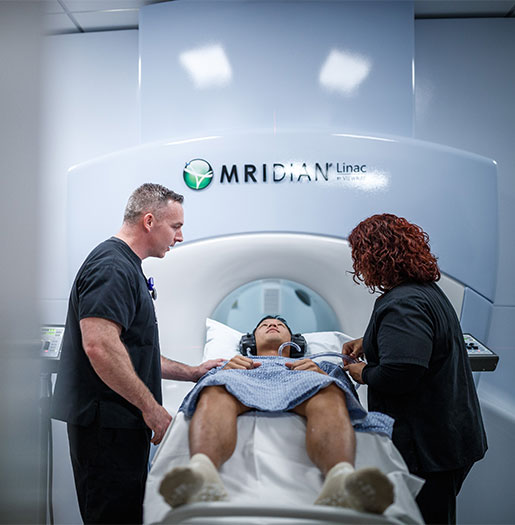Radiation Therapy for Benign Diseases
Radiation therapy is well known for its use in the treatment of cancer. A large number of cancer patients receive radiation therapy at some point during their course of treatment, but radiation therapy may also be administered for benign diseases.
There are several benign conditions that are treated with radiation therapy. For these conditions, the level of evidence to recommend radiotherapy is strong and as such, health insurance providers consider radiotherapy treatment as medically necessary. However, in certain diagnoses, treatment is considered medically necessary when there is failure, intolerance, or contraindication to other established medical or surgical therapies.
 Considered Medically Necessary
Considered Medically Necessary
Desmoid Tumor
Desmoid tumor or aggressive fibromatosis is a non-malignant tumor that usually grows most commonly in the tissues of the abdomen, arms and legs. Although desmoid tumors are not malignant, they can be aggressive and grow into nearby organs or structures. Typical symptoms include a mass or swelling in the involved area, pain and functional impairment. Some desmoid tumors are slow growing and do not require immediate treatment. Otherwise, typical treatment includes surgery, chemotherapy, non-chemotherapy drugs and radiotherapy.
The goal of treatment is to eradicate the desmoid tumor and to improve the symptoms of mass, swelling, pain and functional and organ preservation.
Gynecomastia
Male breast enlargement is not a sign of breast cancer in men. Known as gynecomastia, breast growth in men can result from weight gain or taking certain types of medications. The first sign of gynecomastia is often a soft lump of fatty tissue that may be tender or sore. Just as women can develop noncancerous (benign) breast lumps, so can men. Examples of benign male breast lumps include cysts, lipomas, hematomas, Phyllodes tumors and fat necrosis.
Heterotopic Ossification (H.O.)
H.O. occurs when bone develops in the soft tissues. It usually happens after surgery or injury. There is a rare genetic disorder that predisposes to H.O. formation. Typical symptoms include hard bumps under the skin. This may be painful. If the bone formed is around a joint, it causes difficulty walking or functional impairment. Treatment includes surgery, steroid therapy, drug (non-steroidal) therapy and radiation therapy.
The goal of treatment is to improve or prevent functional impairment and pain, if present.
Dupuytren’s contracture
Dupuytren’s contracture is a type of fibromatosis that causes one or more fingers to bend toward the palm of the hand. These fingers cannot straighten. Knots form under the skin creating a thick cord that pulls the fingers toward the palm of the hand. The condition is painless and without treatment worsens over time. Typical symptoms include the formation of knots and then thick cords. The knots may be tender but not painful. Treatment consists of surgery, steroid injections, needling (a needle is inserted through the skin to break the cord that is contracting the finger), and radiation therapy.
The goal of the treatment is to release the contracted finger(s) and regain the functionality of the affected hand.
Ledderhose disease
Ledderhose disease is a type of fibromatosis that affects the plantar surface of the foot (bottom of the foot). The disease presents with small and hard growth in the bottom of the foot. The growths may be painful making walking difficult. Other symptoms include curling of the toes. Typical treatment includes steroid injections, oral medications, surgery and radiation therapy.
The goal of treatment is to improve walking with no pain or discomfort.
Pigmented villonodular synovitis (PVNS)
PVNS is a benign condition that arises from the soft connective tissue of the joints. Any joint can be affected but is most commonly found in the hip or knee. PVNS can be localized within one area of the joint or diffuse when the entire joint is involved. Typical symptoms include swelling of the affected joint, joint effusion (fluid within the joint), pain and difficulty walking. Treatment includes surgery, drug therapy and radiation therapy.
The goal of treatment is to improve pain, swelling and walking.
Considered Medically Necessary When There is Failure, Intolerance or Contraindication to Other Established Medical or Surgical Therapies
Degenerative skeletal and joint disorders
Degenerative diseases of the skeleton and joints include conditions such as osteoarthritis, plantar fasciitis and other inflammatory conditions affecting joints and tendons. These conditions create inflammation of the affected area which in turn causes pain, swelling, discomfort and functional impairment. Treatment includes oral anti-inflammatories, icing, weight loss, exercise, surgery, and radiation therapy.
The goal of treatment is the improvement of pain and functional impairment.
Keloid scar
A keloid is a raised thick scar that usually forms after skin injury. It can occur anywhere in the body. Typical symptoms are pain and discomfort. If the keloid is large and, depending on location, it can cause functional impairment. Treatment includes steroid injections, surgical removal and radiation therapy.
The goal of treatment is to improve symptoms of pain, discomfort and functional impairment.
Orbital pseudotumor
Orbital pseudotumor is swelling of the tissues behind the eyes. The eyes sit inside the orbits or eye sockets. Typical symptoms include pain, restricted eye movement, decreased eyesight, double vision, and proptosis or eye swelling protruding from the eye socket (proptosis). Treatment includes steroid therapy, surgery and radiation therapy. Mild cases may be observed without treatment and may resolve on their own.
The goal of treatment is to improve symptoms of pain, decreased eyesight, impaired eye motion, discomfort and proptosis.
If you'd like to refer a patient to receive radiation therapy at Moffitt Cancer Center, contact Dr. Jose Penagaricano at Jose.Penagaricano@moffitt.org or call 813-745-8830.
